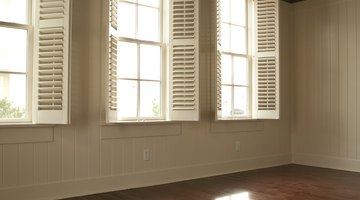How to Install Quarter-Round on Laminate Flooring
Homeowners install quarter-round molding at the base of a wall to hide gaps and imperfections between the wall and a laminate floor or between the baseboard molding and a laminate floor. Quarter-round molding typically offers some flexibility, allowing the molding to sit on the floor, even if the floor is not level.

Quarter-round molding gives the base perimeter of a room a finished look in a variety of room styles, ranging from traditional to modern.
Things You Will Need
- Tape measure
- Miter saw, circular saw or handsaw and miter box
- 220-grit sandpaper
- Assistant
- Construction adhesive
- Finishing nails
- Nail gun
- Power drill
- Hammer
- Nail set
- Paintable latex caulk or wood putty
- Flat-bladed screwdriver
Tip
Paint or stain the molding before attaching it to the wall or baseboard molding. Adjust the baseboard molding with shims or cuts rather than adjusting the quarter-round molding if the floor is considerably out of level.
Warning
Do not nail quarter-round molding to laminate floors, as doing so does not allow for expansion or contraction and may damage the laminate floor. Nailing molding to laminate floor may also cause the laminate flooring to split, crack or otherwise fracture.
-
Measure the length of the wall and note the measurements.
-
Cut the quarter-round molding with a miter saw, circular saw or handsaw and miter box to match the length of the wall. If the wall is longer than the length of molding, use two pieces of molding to cover the base of the wall or baseboard molding.
-
Mark the back of the molding with a pencil to show which wall the molding fits.
-
Put the molding up against the wall to test the fit. Cut the ends of the molding with a saw to adjust the corners as necessary.
-
Sand the rough edges off the molding with 220-grit sandpaper.
-
Run a thin bead of construction adhesive along the back of the molding. Place the molding up against the baseboard molding or wall, allowing the bottom of the molding to sit on the laminate floor. Press the molding tightly against the baseboard molding and wall. Have an assistant hold the molding in place.
-
Shoot finishing nails through the quarter-round molding into the baseboard molding or wall every 8 to 10 inches, using a nail gun. If you are driving nails through the quarter-round molding with a hammer, first drill pilot holes slightly smaller than the diameter of the nail through the molding, using a power drill. Place the tip of a finishing nail in the pilot hole. Strike the nail with a hammer until the nail sits just above the surface of the quarter-round molding. Place a nail set on top of the finishing nail, and hit the nail set with the hammer to drive the finishing nail just below the surface of the quarter-round molding.
-
Continue to apply adhesive and drive the finishing nails through the quarter-round molding until molding covers the base of the wall and rests on the laminate floor.
-
Examine the quarter-round molding for gaps and sections that do not lie flush against the wall or corners that do not meet. Fill the gaps, nail holes and imperfect corners with paintable latex caulk, or, if the moldings have stain, use matching-color wood putty. Press the wood putty or silicone caulk into the gaps with your finger. Use a flat-bladed screwdriver to mold corners and straight flat areas.
The Drip Cap
- Homeowners install quarter-round molding at the base of a wall to hide gaps and imperfections between the wall and a laminate floor or between the baseboard molding and a laminate floor.
- Quarter-round molding typically offers some flexibility, allowing the molding to sit on the floor, even if the floor is not level.
- Sand the rough edges off the molding with 220-grit sandpaper.
- Place a nail set on top of the finishing nail, and hit the nail set with the hammer to drive the finishing nail just below the surface of the quarter-round molding.
- Press the wood putty or silicone caulk into the gaps with your finger.
References
- "Reader's Digest Complete Do-It-Yourself Manual"; Family Handyman Magazine Editors; 2005
- "Trimwork"; Creative Homeowner Editors; 2010
- ”The Book of Skills and Tools"; Family Handyman Magazine Editors; 1993
Writer Bio
Sal Marco began writing professionally in 2009. He has written many online home improvement articles based on his more than 20 years of experience in the home improvement and building industries. He has worked as both part of a team and as a site supervisor. Marco has a Bachelor of Science in management science from Kean University.
Photo Credits
- Comstock Images/Comstock/Getty Images
- Comstock Images/Comstock/Getty Images
More Articles



